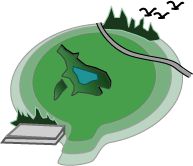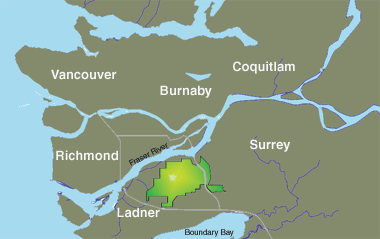|
|
Welcome
to the
Joho Guide to Burns Bog |
|
|
Introduction Burns Bog is situated on the delta of the Fraser River, in the southwest corner of the Province of British Columbia, Canada. Being on the west coast of North America, the Fraser Delta Region enjoys a temperate climate throughout the year. The high rainfall of the west coast, especially during the winter months, allows for the growth of temperate rainforests. Without modern human disturbances, much of the Lower Fraser Valley would have been covered with dense temperate forests, characterized by tall evergreen trees, such as Douglas fir (Pseudotsuga menziesii), Western red-cedar (Thuja plicata), Western hemlock (Tsuga heterophylla), and Lodgepole pine (Pinus contorta). If we were to turn back time and have a bird's eye view of the region, we would see a few breaks to the dominant vegetation pattern. On the waterlogged soils and sediments of the Fraser Delta, various types of wetlands would appear to be quite distinctive from their forested surroundings. The mudflats along margins of the Delta would form one group of wetlands. The other type of wetlands would be bogs. Bogs used to occupy well over a quarter of Lulu Island and parts of southern Burnaby. Burns Bog was the biggest amongst the Fraser Delta bogs. Elsewhere in the Lower Fraser Valley, many smaller bogs existed. Bogs are quite different from other wetlands in terms of plants and animals. Much of the difference is initially caused by bogs' special hydrology. Unlike most ecosystems, which receive water from precipitation and groundwater flow, the surface of bogs gets a very small amount of water from groundwater sources. Precipitation, therefore, is the principle source of water for bogs. Because of the special hydrology of bogs, these ecosystems have very few minerals available for plant growth. This poor growth condition limits the growth of plants that are common elsewhere in the region. Lodgepole pine, which grows to be several metres tall, would usually only grow to only one metre in height. Sphagnum moss, which is unique to bogs, blankets a bog. Other plants, which are typical of subarctic parts of Canada, survive such harsh conditions and thrive in Burns Bog. Some of these plants include Labrador Tea (Ledum groenlandicum), Crowberry (Empetrum nigrum), and Greater reindeer lichen (Cladonia rangiferina). Other species has their own way to adapt. The Round-leaved and Long-leaved sundew (Drosera rotundifolia & Drosera anglica), for instance, got their nutrients from insects. The above describes what an undisturbed bog looks like, that is, without human interruption of the ecology. Burns Bog, like all other Lower Mainland bogs, has been seriously disturbed. Although many First Nations groups have used Burns Bog for a very long time, human disturbance has only started to significantly alter the bog ecology in modern times. During the 20th century, the vegetation patterns of Burns Bog have changed dramatically. Some plants that used to be common throughout the Bog are now very rare. Because of the change in the hydrology and infiltration of nutrients, non-bog plants continue to infringe into the Bog. There are now many more plants species introduced from Europe, Asia, and Eastern North America. Some of these exotic species grow vigorously in the Bog, taking over sites which were originally occupied by native plants. The history is similar for animals. The presence of some bog plants such as bog bilberries (Vaccinium uliginosum) attracted a sizable black bear (Ursus americanus) population in Burns Bog. Due to widespread human disturbances within and around the Bog, the bears have almost disappeared from the Bog. Many migratory birds, including the Greater Sandhill Crane (Grus canadensis), used to blacken the sky in the thousands during their migration movements. Now, because of the loss of habitats along migratory routes, the number of migratory birds in west coast habitats such as Burns Bog has significantly decreased. Aside from the bears and the cranes, habitat loss due to human disturbance has also affected many bird, mammal, reptile, amphibian and insect species. Burns Bog, despite being heavily disturbed, still provides habitats, breeding grounds, and sources of food for wildlife. It is our pleasure to invite you to visit the Bog and its inhabitants and share the information in this web site. Have a good trip!
Copyright Johomaps.com |
||

